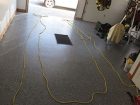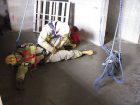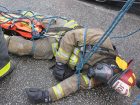
Back to Basics: Janaury 2015
Mark Van
Features Fire Ground TrainingWe are continuing to look at sub-level rescues of a downed firefighter with a focus on rescue tactics. In October, we went over the use of rope to rescue a firefighter who is conscious and able to assist in the rescue process. Here, we are going to focus on tactics to rescue an unconscious downed firefighter, or a downed firefighter who is immobile due to an injury or an impedance of some sort.
The primary tool for a sub-level rescue of an unconscious firefighter is life-safety rope formed into handcuff knots. While one set of handcuff knots is sufficient to rescue a conscious firefighter, two sets are necessary when attempting to rescue an unconscious firefighter; this allows for one or more firefighters from the rapid intervention team (RIT), and the necessary equipment, to be lowered down to the sub-level, or basement.
Rescue teams need to assess the situation to determine how many RIT firefighters should be sent down for the rescue. If significant manpower is needed to free the downed firefighter, three RIT firefighters, ideally, should be available for lowering. Generally, more than three RIT firefighters creates congestion and slows the operation.
When setting up the rescue, make sure the area around the opening has been secured and stabilized for the crew to work around. Standing too close to the edge of the opening through which the downed firefighter has fallen exposes other firefighters to potential risk.
At least four RIT firefighters are required at the sub-level opening to operate the ropes and equipment; two sets of handcuff knots require four separate ropes and therefore four firefighters. As you can see in photo 1, the ropes are laid out in a V fashion on each side of the opening. (In this photo, the black mat portrays the opening.) The two handcuff knots are positioned at one end of the opening.
The first RIT firefighter prepares to be lowered down by securing one set of handcuff knots around his feet, crossing one foot over the other to secure the knots, and grabbing the two sections of rope with his hands. The firefighter then makes himself stiff by standing up on the handcuff knot while two other RIT firefighters hold and control the ropes extending from the knot. (This was explained in detail in the October column, which you can see online at www.firefightingincanada.com under Training/Structural.)
Once the first RIT firefighter is lowered to the downed firefighter, he can begin to assess the situation by locating and turning off the PASS alarm. Next, he notifies the incident commander that the team has located the downed firefighter and is beginning the removal process. At this point, the second RIT firefighter should be lowered down to help with the assessment.
The next step is to determine whether the downed firefighter is breathing, which can be done by leaning in close to his SCBA face piece and listening. If the downed firefighter is not breathing, and is not trapped by any debris or other obstruction, a grab-and-go operation is required so that proper resuscitation can take place in a safer environment with access to advanced life-support measures.
If the downed firefighter is breathing, check the air supply by either connecting the rapid intervention crew (RIC) valve to the SCBA, changing the regulator, or changing the face piece. The RIT kit, along with any other necessary equipment, is lowered down by the rescue team using ropes and handcuff knots (see photo 2); large or extra-large carabineers work well for securing the equipment for lowering and are easy for the receiving team to handle.
While assessing the downed firefighter, rescuers should take into account any obstructions or impedances. The downed firefighter might be pinned by fallen debris that requires lifting using air bags or hydraulic tools and cribbing; it is the responsibility of the rescue team to acquire and prepare the equipment for lowering. Assigning an interior operations-sector officer to liaise with command and the interior RIT members is helpful in this type of situation.
In the case of a lengthy operation, consider implementing a work cycle; this might involve lowering new or fresh RIT firefighters and raising RIT firefighters who have been working for a while, which adds to the manpower needed for the operation.
Once the assessment is complete and the downed firefighter is ready for removal with his or her SCBA converted into a harness, ensure that there are no entanglements and check that the RIT kit is secured to the downed firefighter. Then, secure the rescue ropes around the downed firefighter for lifting (see photo 3).
Two sets of handcuff knots are used to secure both the arms and the legs of the downed firefighter so that, when lifted up, it looks as if the downed firefighter is in a reclined, seated position. In order for this to be accomplished, one set of handcuff knots is placed around the bicep area of each arm to ensure a good anchor point on the upper body; the second set of knots goes around the upper thighs of each leg.
Once the knots are cinched up tightly, the RIT members on the top level begin the lifting operation. With a minimum of one firefighter on each rope, the team quickly and effectively raises the downed firefighter up. Once the downed firefighter has been raised to the the top of the opening, other RIT members grab him and move him away from the hole to a safe and secure area.
At this point, the downed firefighter is removed from the building. The quickest and shortest route available for transport is chosen and readied ahead of time by another rapid intervention team.
Mark van der Feyst is a full-time firefighter in Ontario and has been in the fire service since 1999. Mark teaches in Canada, the United States and India. He is a local-level suppression instructor for the Pennsylvania State Fire Academy and an instructor for the Justice Institute of BC. He is also the lead author of Pennwell’s Residential Fire Rescue book. Email Mark at Mark@FireStarTraining.com
Print this page


